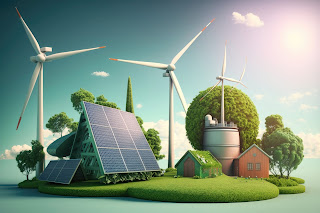A Deep Dive into Renewable Energy Developments
As the world grapples with the challenges of climate change and the depletion of traditional energy sources, the spotlight on renewable energy has never been brighter. In the quest for sustainable and cleaner alternatives, technological advancements, policy shifts, and innovative solutions are driving significant developments in the renewable energy sector. This article explores the key trends and breakthroughs shaping the landscape of renewable energy, from solar and wind power to emerging technologies on the horizon.
I. Solar Power Revolution:
Solar energy has emerged as a frontrunner in the race towards sustainable power sources. Advancements in photovoltaic (PV) technology have significantly improved the efficiency and affordability of solar panels. Thin-film solar cells, perovskite solar cells, and bifacial modules are among the innovations enhancing energy capture and conversion. The integration of solar power into building materials, such as solar roof tiles, is transforming the way we think about energy generation and consumption.
II. Wind Energy: From Turbines to Offshore Farms:
Wind energy continues to be a stalwart in the renewable energy portfolio. The evolution of wind turbine technology, including larger and more efficient designs, has led to increased energy output and reduced costs. Offshore wind farms, situated in coastal areas with strong and consistent winds, are becoming a major contributor to the global energy grid. Floating wind turbines, designed for deep-sea installations, represent a promising frontier for harnessing wind energy in regions where traditional fixed structures are impractical.
III. Energy Storage and Grid Integration:
Addressing the intermittent nature of renewable energy sources is a critical aspect of their widespread adoption. Energy storage technologies, such as advanced batteries and pumped hydro storage, play a pivotal role in balancing supply and demand. Grid-scale energy storage solutions enable the storage of excess energy during peak production times for later use, contributing to grid stability and reliability.
IV. Hydropower Innovations:
While traditional hydropower remains a significant source of renewable energy, new developments are reshaping its landscape. Run-of-river hydropower projects minimize environmental impacts by diverting a portion of the river flow to generate electricity without the need for large dams. In-stream hydrokinetic technologies, which harness the energy from flowing water, offer opportunities for smaller-scale hydroelectric power generation in rivers and tidal currents.
V. Geothermal Energy:
Geothermal energy, derived from the Earth's internal heat, is gaining attention as a reliable and consistent power source. Enhanced geothermal systems (EGS) involve the injection of water into hot rock formations to create steam, which is then used to drive turbines for electricity generation. Geothermal power plants can operate continuously, providing a baseload power supply that complements the intermittent nature of solar and wind energy.
VI. Tidal and Wave Energy:
Harnessing the power of ocean tides and waves is an area of ongoing research and development. Tidal energy, generated by the gravitational forces between the Earth, the Moon, and the Sun, can be captured using underwater turbines. Wave energy converters, designed to extract energy from the motion of ocean waves, are also being explored as a promising avenue for renewable power generation.
VII. Bioenergy and Sustainable Biomass:
Bioenergy, derived from organic materials such as plants and waste, represents a versatile and renewable energy source. Advanced biofuels, produced from non-food feedstocks, offer cleaner alternatives to traditional fossil fuels for transportation. Biomass power plants, utilizing organic materials to generate electricity, contribute to the diversification of renewable energy options.
VIII. Policy and Market Drivers:
Government policies and market dynamics play a crucial role in shaping the renewable energy landscape. Incentives, subsidies, and regulatory frameworks that prioritize clean energy solutions incentivize investment and innovation. The increasing competitiveness of renewable energy in comparison to conventional sources is driving a global shift towards sustainable energy practices.
IX. The Role of Corporate Initiatives:
Corporate commitments to sustainability and environmental responsibility are influencing renewable energy developments. Many companies are pledging to transition to 100% renewable energy, driving demand for large-scale renewable projects and contributing to the growth of the renewable energy market.
X. Challenges and Future Outlook:
Despite remarkable progress, challenges persist in the widespread adoption of renewable energy. Intermittency, energy storage limitations, and the need for extensive infrastructure upgrades pose hurdles to seamless integration. Overcoming these challenges requires continued research, investment, and collaboration across sectors.
As we look to the future, emerging technologies such as advanced nuclear power, artificial photosynthesis, and innovative energy capture methods hold promise for further revolutionizing the renewable energy landscape. The collective effort to transition towards sustainable energy sources is not just a technological imperative but a global commitment to securing a cleaner, more resilient future.
Conclusion:
Renewable energy developments represent a beacon of hope in the quest for a sustainable and environmentally conscious energy future. From the relentless innovation in solar and wind technologies to the exploration of novel sources like tidal and geothermal energy, the renewable energy landscape is dynamic and evolving. As technology, policy, and market forces continue to converge, the transition to a renewable energy paradigm becomes not just a possibility but an imperative for the well-being of our planet and future generations.




Comments
Post a Comment